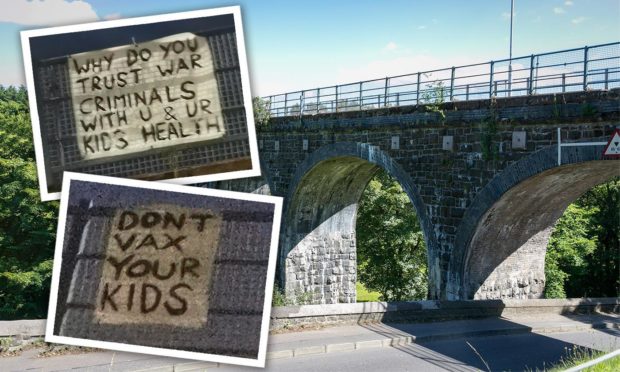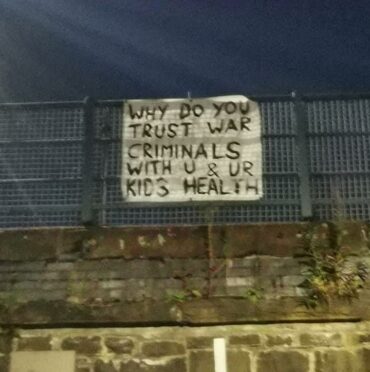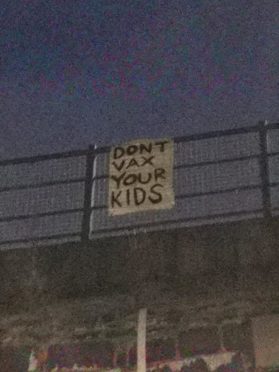Two large anti-vaccination posters have sparked debate after they were spotted on the viaduct between Leslie and Glenrothes.
The signs were attached to the railway viaduct railing by zip ties, making them difficult to remove.
One poster, spotted on Wednesday night, read in big writing: “Don’t vax your kids.”
The other poster read: “Why do you trust war criminals with u & ur kids health.”
Both have since been taken down.
Amy Murray, a local resident, said she is mainly neutral about the posters.
She said: “I think if people have an opinion and want to advertise it then it’s perfectly fine to do.
“The government has Covid vaccination leaflets, posters plastered everywhere, so why can’t people who don’t agree on the vaccination do the same?”
Fife Council said any members of the public who spot materials that could cause offence should report it to them.
Kirstie Freeman, service manager (safer communities), said: “We aim to remove any material that could cause offence as soon as possible after it is reported to us.
“We rely on the public coming forward and reporting this kind of activity to us.
“You can do this online at www.fife.gov.uk or phone 03451 55 00 22.”
Do vaccines work?
The Courier’s data team have created a series of charts to show the impacts of the vaccine on the number of acute hospital admissions, deaths and seven day case-rate per 100,000 collated from weekly data provided by Public Health Scotland.
Data has been analysed by Public Health Scotland on confirmed Covid-19 deaths since the start of the vaccination rollout in December last year.
The chart shows 3,096 people who were unvaccinated had died from Covid-related deaths compared to 264 people who had received two doses of the vaccine.
Data also shows however, that being double jabbed does not necessarily stop people being admitted to hospital.
The chart below shows during the end of last week, 261 of fully dosed patients were acutely admitted to hospital, compared to 34 who had received one dose and 153 who have not been vaccinated.
Data on the seven day case-rate by vaccination status shows the difference between the rate in the unvaccinated population compared with people who have received both doses.
This chart shows unvaccinated people appear to be catching Covid more than those fully vaccinated as on Wednesday, 1500 unvaccinated people per 100,000 contracted covid within seven days compared to 420 fully vaccinated people.
If backed in the Scottish Parliament, Nicola Sturgeon announced this week that Covid vaccine passports are to be introduced in Scotland from the end of this month.
This means that people in Scotland would need proof of double dosage to get into ‘non-essential settings’, which includes nightclubs as well as some indoor and outdoor events.
Covid vaccine in Scotland: Track the rollout progress with these charts


